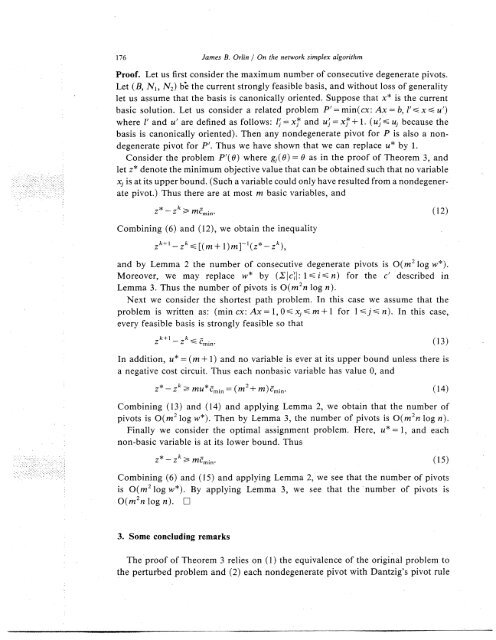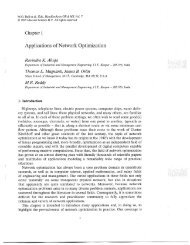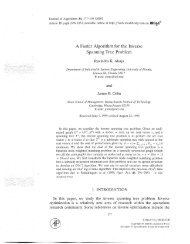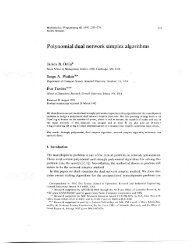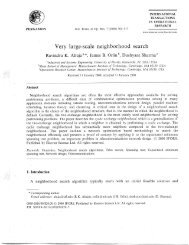ON THE SIMPLEX ALGORITHM FOR NETWORKS ... - James B. Orlin
ON THE SIMPLEX ALGORITHM FOR NETWORKS ... - James B. Orlin
ON THE SIMPLEX ALGORITHM FOR NETWORKS ... - James B. Orlin
You also want an ePaper? Increase the reach of your titles
YUMPU automatically turns print PDFs into web optimized ePapers that Google loves.
176<br />
<strong>James</strong> B. <strong>Orlin</strong> / On the network simplex algorithm<br />
''<br />
·<br />
''"<br />
-·,<br />
Proof. Let us first consider the maximum number of consecutive degenerate pivots.<br />
Let (B, N 1 , N2) be the current strongly feasible basis, and without loss of generality<br />
let us assume that the basis is canonically oriented. Suppose that x* is the current<br />
basic solution. Let us consider a related problem P' = min(cx: Ax = b, ' x S u')<br />
where ' and u' are defined as follows: Ij = x and u = x + 1. ( j because the<br />
basis is canonically oriented). Then any nondegenerate pivot for P is also a nondegenerate<br />
pivot for P'. Thus we have shown that we can replace u* by 1.<br />
Consider the problem P'(O) where g() = 0 as in the proof of Theorem 3, and<br />
let z* denote the minimum objective value that can be obtained such that no variable<br />
xj is at its upper bound. (Such a variable could only have resulted from a nondegenerate<br />
pivot.) Thus there are at most m basic variables, and<br />
z*- Z mCmi n (12)<br />
Combining (6) and (12), we obtain the inequality<br />
zk - z k ~ [(m + 1)m]-L (z*zk),<br />
and by Lemma 2 the number of consecutive degenerate pivots is O(m 2 log w*).<br />
Moreover, we may replace w* by (ct'l 1 i n) for the c' described in<br />
Lemma 3. Thus the number of pivots is O(m 2 n log n).<br />
Next we consider the shortest path problem. In this case we assume that the<br />
problem is written as: (min cx: Ax= 1, O


